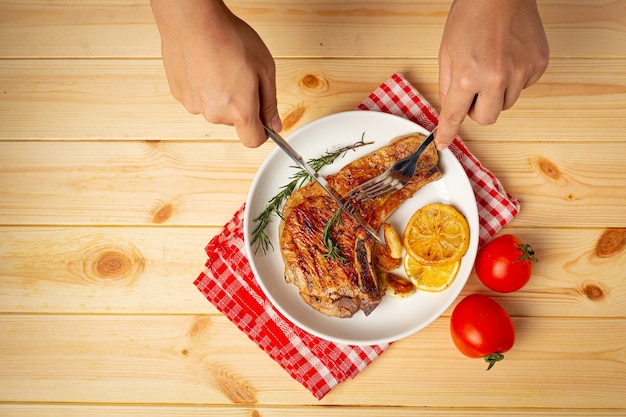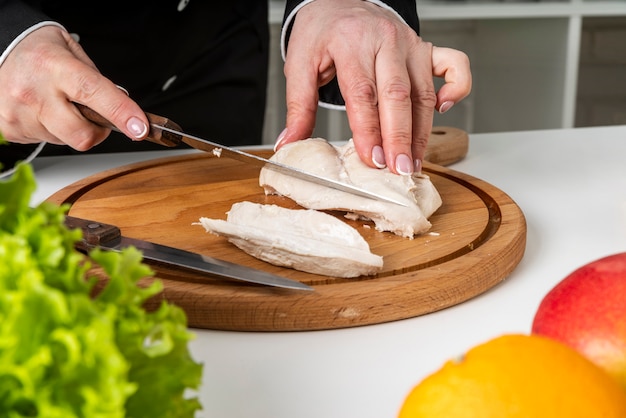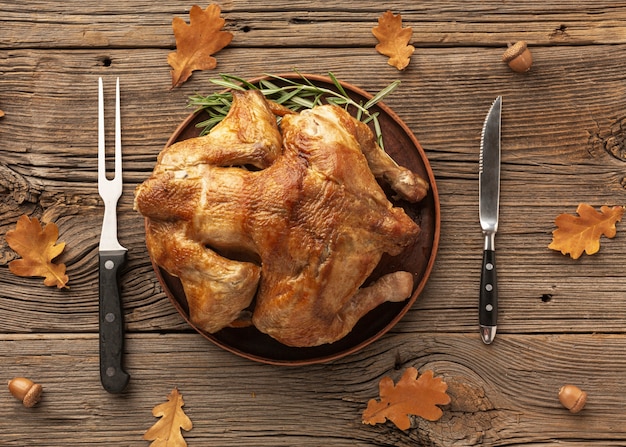As a seasoned cook, I've always had a special fondness for chicken thighs. They're incredibly versatile and always deliver juicy, flavorful results. But I'll admit, I've had my fair share of overcooked chicken thighs, ending up with dry, disappointing meals. Determined to master this kitchen staple, I've spent countless hours researching and experimenting, and I'm thrilled to share my knowledge with you.
This comprehensive guide will take you on a culinary journey through the world of chicken thigh cooking. We'll explore different cooking methods, factors that influence cooking time, and insider tips to ensure juicy, melt-in-your-mouth results every time. Get ready to become a chicken thigh virtuoso!
(Part 1) The Alluring Chicken Thigh: Getting to Know Your Ingredient

Before diving into cooking times, let's understand the beauty of the chicken thigh. It's a cut of meat that deserves more appreciation, and knowing its characteristics will help you unlock its full potential.
Why Choose Chicken Thighs?
Chicken thighs are simply more flavorful than their breast counterparts. The higher fat content gives them a richer taste and helps them stay moist even when cooked for longer. This makes them perfect for slow cooking and roasting, where the fat renders down, creating a delicious, flavorful sauce. Think of it as a culinary superpower! They're also more forgiving, less likely to dry out if you're not a seasoned chef.
Skin On or Skin Off: The Great Debate
This is a personal preference, but I'm a strong advocate for leaving the skin on. The skin acts as a protective barrier, preventing moisture loss during cooking. It also renders down, adding flavor and richness to the dish. It's like a little culinary secret ingredient! But if you're watching your fat intake, removing the skin is a perfectly valid choice.
Bone-In or Boneless: The Choice is Yours
Again, personal preference reigns supreme! Bone-in thighs tend to be more flavorful, as the bone helps retain moisture and adds a subtle richness to the dish. They're also great for slow cooking, as the bone adds depth to the resulting sauce. Boneless thighs, on the other hand, are easier to handle and can be cooked more quickly, making them ideal for quick weeknight meals.
(Part 2) Mastering Chicken Thigh Cooking: A Time-Based Guide

Now, let's get to the heart of the matter: cooking time. There's no single answer because cooking time depends on several factors. Let's break it down method by method.
Oven Cooking: The Tried and True
Oven cooking is a classic method, especially when you're making a batch for a crowd. Here's a general guideline for oven cooking times:
- Bone-in, Skin-on: 30-40 minutes at 350°F (175°C). This allows the fat to render, creating a succulent result.
- Boneless, Skin-on: 20-25 minutes at 350°F (175°C). Quick and flavorful!
- Boneless, Skinless: 15-20 minutes at 350°F (175°C). Best for when you want a leaner option.
Remember, these are just estimates. Always use a meat thermometer to ensure your chicken is cooked through, reaching an internal temperature of 165°F (74°C) for safe consumption.
Skillet Cooking: Fast and Delicious
For a quick and easy weeknight meal, skillet cooking is your best friend. You can achieve crispy, browned chicken thighs in just a few minutes. Here's a general guide for skillet cooking times:
- Bone-in, Skin-on: 10-15 minutes per side over medium heat. This allows the skin to crisp up beautifully.
- Boneless, Skin-on: 5-8 minutes per side over medium heat. Quick and easy!
- Boneless, Skinless: 4-6 minutes per side over medium heat. Perfect for quick stir-fries.
Before adding your chicken, heat the pan well to ensure even browning and crispy skin. Don't overcrowd the pan, and you'll be rewarded with delicious results.
Grill Cooking: Smoky Goodness
grilling chicken thighs adds a smoky depth of flavor. Preheat your grill to medium-high heat and get ready for a delicious experience. Here's a general guideline for grilling times:
- Bone-in, Skin-on: 10-15 minutes per side, with the lid closed. This allows the chicken to cook evenly and develop a smoky flavor.
- Boneless, Skin-on: 6-8 minutes per side, with the lid closed. Perfect for a quick grilling session.
- Boneless, Skinless: 4-6 minutes per side, with the lid closed. Ideal for grilling with other vegetables.
Keep a close eye on your chicken and ensure it's cooked through. It's better to err on the side of caution and cook a little longer than to risk undercooking.
Slow Cooking: Tenderness Personified
Slow cooking is a masterclass in tenderness, perfect for transforming tougher cuts of meat into melt-in-your-mouth delights. Here's a general guide for slow cooking times:
- Bone-in, Skin-on: 4-6 hours on low or 2-3 hours on high. This allows the chicken to become incredibly tender and flavorful.
- Boneless, Skin-on: 3-4 hours on low or 1-2 hours on high. A quick and easy way to achieve succulent chicken.
- Boneless, Skinless: 2-3 hours on low or 1 hour on high. Perfect for slow cooking with other ingredients.
Remember to adjust cooking time based on the size and thickness of your chicken thighs. Always check the internal temperature to ensure it's reached 165°F (74°C) for safe consumption.
(Part 3) The Art of perfect chicken Thighs: Unveiling the Nuances

Now that we've covered the basics, let's explore some factors that influence cooking time and can make a world of difference in achieving perfectly cooked chicken thighs.
Size and Thickness: It Matters
It's common sense, but larger and thicker thighs will take longer to cook than smaller and thinner ones. Always consider the size of your chicken thighs when determining cooking time. It's always better to err on the side of caution and add a few extra minutes if you're unsure.
Doneness Preference: Pink or White?
Some prefer their chicken thighs with a slightly pink center, while others like them fully cooked through to a completely white color. This preference will affect your cooking time. If you prefer a slightly pink center, you can reduce the cooking time slightly. However, always ensure your chicken reaches a safe internal temperature of 165°F (74°C) for safe consumption.
Oven Temperature: The Heat Factor
Oven temperature plays a crucial role in cooking time. A higher temperature will cook your chicken faster, while a lower temperature will require a longer cooking time. If a recipe calls for a specific temperature, try to stick to it. However, if you're unsure, it's always better to start with a lower temperature and adjust as needed. You can always increase the temperature if you need to speed up the process.
Crowding the Pan: Space is Key
When cooking in a pan or skillet, it's essential to avoid overcrowding. Too much chicken in the pan will result in steaming rather than browning, leading to uneven cooking. Cook your chicken in batches, ensuring enough space for each piece to brown evenly.
(Part 4) Unlocking the Secrets of juicy chicken Thighs
Now that we've explored the factors that affect cooking time, let's discuss some tips for ensuring juicy, delicious chicken thighs every time. These tips are your secret weapons for success.
Brining: The Moisture-Boosting Technique
Brining is a simple technique that involves soaking chicken thighs in a saltwater solution before cooking. It helps retain moisture, resulting in tender, juicy chicken. You can find countless brining recipes online, but I generally use a simple mixture of water, salt, and sugar. Submerge the chicken thighs in the brine for 30 minutes to a couple of hours, depending on the size of the thighs. Don't forget to pat the chicken dry before cooking!
Pat Dry: Essential for Crispy Skin
Before cooking, always pat your chicken thighs dry with paper towels. This removes excess moisture, which helps achieve crispy skin. A dry surface allows for better browning and a more flavorful crust.
Meat Thermometer: Your Culinary Ally
A meat thermometer is an invaluable tool for any cook. It allows you to check the internal temperature of your chicken without having to cut into it, ensuring it's cooked through and safe to eat. Always aim for an internal temperature of 165°F (74°C).
Resting: The Secret to Juiciness
After cooking, give your chicken thighs a few minutes to rest before slicing. This allows the juices to redistribute, resulting in more flavorful and tender meat. Cover the chicken loosely with foil to keep it warm while resting.
(Part 5) Chicken Thigh Inspiration: A culinary adventure Awaits
Now that you're equipped with all the knowledge you need to cook perfect chicken thighs, let's spark your culinary creativity with some delicious recipe ideas.
Roasted Chicken Thighs with Lemon and Herbs
This classic recipe is a crowd-pleaser and showcases the versatility of chicken thighs. The lemon juice adds a bright citrusy flavor, while the herbs provide a fragrant aroma. The crispy skin and tender meat are truly irresistible!
Chicken Thighs with Creamy Mushroom Sauce
For a comforting and decadent meal, try this chicken thigh recipe with creamy mushroom sauce. The mushrooms are sautéed in butter until golden brown, then simmered in a creamy sauce with fresh herbs. The chicken thighs are pan-fried until golden brown and then added to the sauce to absorb all those delicious flavors.
One-Pan Chicken Thighs with Roasted Vegetables
This easy and healthy recipe is perfect for a weeknight meal. Simply toss chicken thighs with chopped vegetables like broccoli, carrots, and onions, season with herbs and spices, and roast in the oven until the chicken is cooked through and the vegetables are tender.
Chicken Thigh Curry with Coconut Milk
For a taste of adventure, try this vibrant and flavorful chicken thigh curry. The chicken thighs are simmered in a fragrant curry sauce made with coconut milk, curry powder, and other spices. Serve it with rice or naan bread for a delicious and satisfying meal.
Chicken Thigh Fajitas with Peppers and Onions
These easy-to-make chicken thigh fajitas are always a hit! The chicken thighs are marinated in a mixture of lime juice, chili powder, and cumin, then grilled or pan-fried until cooked through. Serve them with warm tortillas, peppers, onions, and your favorite toppings for a fiesta in your mouth!
(Part 6) food safety: Cooking with Confidence
Now that we've explored the joys of cooking chicken thighs, let's talk about safety. It's crucial to handle and cook chicken safely to prevent foodborne illness.
Wash Your Hands: A Crucial First Step
Before, during, and after handling raw chicken, wash your hands thoroughly with soap and warm water for at least 20 seconds. This helps to remove any harmful bacteria that could contaminate other surfaces or foods.
Keep Surfaces Clean: A Clean Kitchen is a Safe Kitchen
Wipe down countertops, cutting boards, and utensils with hot soapy water after handling raw chicken. This ensures that any bacteria from the chicken doesn't spread to other foods.
Don't Cross-Contaminate: Separate and Conquer
Avoid using the same utensils or cutting boards for raw chicken and other foods. This helps to prevent the spread of bacteria. It's also essential to separate raw chicken from other foods in your refrigerator to avoid cross-contamination.
Cook to Safe Temperature: The Golden Rule
The most important safety tip is to cook chicken to a safe internal temperature of 165°F (74°C). Use a meat thermometer to ensure the chicken is cooked through. This helps to kill any harmful bacteria that may be present.
(Part 7) Beyond Chicken Thighs: Exploring Alternatives
Sometimes, you might not have chicken thighs on hand. Don't worry! There are some great substitutes you can use in your recipes.
chicken breasts: A Familiar Friend
Chicken breasts are a common substitute for chicken thighs. However, they tend to be leaner and can become dry if overcooked. To ensure juicy results, use a brining solution or reduce the cooking time. You can also add a bit of fat, like butter or olive oil, to the pan to help keep the chicken moist.
chicken wings: Another Delightful Option
Chicken wings are another great option, especially for grilling or frying. They are similar in texture to chicken thighs and can be cooked in a variety of ways. Just adjust the cooking time based on the size and weight of the wings.
Other Poultry: Expand Your Horizons
If you're looking for something different, you can try other poultry like duck, turkey, or goose. Just remember to adjust the cooking time and temperature based on the specific type of poultry you're using. These poultry options will add a unique flavor to your dishes.
(Part 8) Storing and Freezing Chicken Thighs: Maintaining Freshness
Proper storage and freezing techniques are essential for maintaining the quality and freshness of your chicken thighs. Let's ensure your chicken stays in tip-top shape.
Refrigerator Storage: Keeping it Fresh
Store raw chicken thighs in the refrigerator for up to 3-4 days. Wrap them tightly in plastic wrap or place them in a sealed container. Make sure to store them on a lower shelf in the refrigerator to prevent any juices from dripping onto other foods.
Freezing Chicken Thighs: Long-Term Storage
For longer storage, you can freeze chicken thighs for up to 2-3 months. Wrap them tightly in plastic wrap and then place them in a freezer-safe bag or container. Make sure to label the bag or container with the date you froze the chicken.
Defrosting Chicken Thighs: The Right Way
When you're ready to use your frozen chicken thighs, thaw them in the refrigerator overnight. You can also thaw them in a bowl of cold water, changing the water every 30 minutes. Never thaw chicken thighs at room temperature, as this can encourage bacterial growth. Once thawed, cook the chicken thighs within 1-2 days.
FAQs: Your Chicken Thigh Questions Answered
Here are some frequently asked questions about cooking chicken thighs:
1. Can I cook chicken thighs from frozen?
It's not recommended to cook chicken thighs from frozen, as they might not cook evenly. It's best to thaw them completely in the refrigerator before cooking.
2. How can I tell if my chicken thighs are cooked through?
Use a meat thermometer to ensure the internal temperature reaches 165°F (74°C). You can also check by cutting into the thickest part of the chicken. The juices should run clear, and the meat should be no longer pink.
3. Can I reuse the fat rendered from chicken thighs?
Absolutely! The rendered chicken fat, known as schmaltz, is incredibly flavorful. It can be used for cooking vegetables, frying potatoes, or adding richness to soups and stews.
4. What are some good side dishes for chicken thighs?
Chicken thighs pair well with a variety of side dishes, such as roasted vegetables, mashed potatoes, rice pilaf, couscous, green beans, or salads. Choose a side dish that complements the flavors of your chicken thigh recipe.
5. Can I grill chicken thighs with bone-in?
Yes, you can grill chicken thighs with bone-in. Just be sure to keep an eye on them and adjust the cooking time as needed. Remember to turn the chicken thighs halfway through to ensure even cooking.
I hope this comprehensive guide has provided you with all the knowledge you need to cook perfect chicken thighs. Experiment with different cooking methods and recipes, and don't be afraid to get creative in the kitchen. Remember, practice makes perfect, and soon you'll be a chicken thigh master!
Everyone is watching

How to Cook Frozen Lobster Tails Perfectly: A Step-by-Step Guide
RecipesLobster. Just the word conjures up images of lavish meals, special occasions, and a taste of luxury. But let's...

Pigs in a Blanket Cooking Time: How Long to Bake for Perfect Results
RecipesAh, pigs in a blanket. Just the name conjures up images of those delightful little parcels of crispy pastry en...

Pork Fillet Cooking Time: How Long to Cook It Perfectly
RecipesPork fillet, or tenderloin as it's sometimes called, is a real favourite in our house. It's so versatile, and...

The Ultimate Guide to Cooking Delicious Frankfurters
RecipesLet's face it, we all love a good frankfurter. It's a classic, simple, and always satisfying. But let's be rea...

The Ultimate Guide to Tender, Juicy Pulled Pork
RecipesRight, let's talk pulled pork. It's one of those dishes that just screams "comfort food," doesn't it? I mean...
